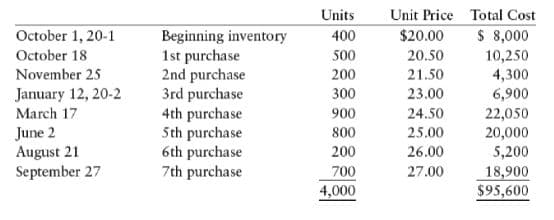1st purchase 3rd purchase 4th purchase 5th purchase 6th purchase 7th purchase 100 are from October 18, 20-1 200 are from January 12, 20-2 100 are from March 17 400 are from June 2 200 are from August 21 300 are from September 27 Units Unit Price Total Cost October 1, 20-1 $20.00 $ 8,000 Beginning inventory 1st purchase 2nd purchase 3rd purchase 4th purchase 5th purchase 6th purchase 7th purchase 400 October 18 500 20.50 10,250 4,300 November 25 200 21.50 January 12, 20-2 March 17 300 23.00 6,900 900 24.50 22,050 20,000 June 2 August 21 September 27 800 25.00 200 26.00 5,200 700 27.00 18,900 $95,600 4,000
1st purchase 3rd purchase 4th purchase 5th purchase 6th purchase 7th purchase 100 are from October 18, 20-1 200 are from January 12, 20-2 100 are from March 17 400 are from June 2 200 are from August 21 300 are from September 27 Units Unit Price Total Cost October 1, 20-1 $20.00 $ 8,000 Beginning inventory 1st purchase 2nd purchase 3rd purchase 4th purchase 5th purchase 6th purchase 7th purchase 400 October 18 500 20.50 10,250 4,300 November 25 200 21.50 January 12, 20-2 March 17 300 23.00 6,900 900 24.50 22,050 20,000 June 2 August 21 September 27 800 25.00 200 26.00 5,200 700 27.00 18,900 $95,600 4,000
Corporate Financial Accounting
14th Edition
ISBN:9781305653535
Author:Carl Warren, James M. Reeve, Jonathan Duchac
Publisher:Carl Warren, James M. Reeve, Jonathan Duchac
Chapter6: Inventories
Section: Chapter Questions
Problem 6.2BE: Perpetual inventory using FIFO Beginning inventory, purchases, and sales for Item Zeta9 are as...
Related questions
Topic Video
Question
SPECIFIC IDENTIFICATION, FIFO, LIFO, AND WEIGHTED-AVERAGE Swing Company’s beginning inventory and purchases during the fiscal year ended September 30, 20-2, were as follows:
Use the following information for the specific identification method.
There are 1,300 units of inventory on hand on September 30, 20-2. Of these 1,300 units:
REQUIRED
Calculate the total amount to be assigned to cost of goods sold for the fiscal year ended September 30, 20-2, and ending inventory on September 30, 20-2, under each of the following periodic inventory methods:
1. FIFO
2. LIFO
3. Weighted-average (round calculations to two decimal places)
4. Specific identification

Transcribed Image Text:1st purchase
3rd purchase
4th purchase
5th purchase
6th purchase
7th purchase
100 are from October 18, 20-1
200 are from January 12, 20-2
100 are from March 17
400 are from June 2
200 are from August 21
300 are from September 27

Transcribed Image Text:Units
Unit Price Total Cost
October 1, 20-1
$20.00
$ 8,000
Beginning inventory
1st purchase
2nd purchase
3rd purchase
4th purchase
5th purchase
6th purchase
7th purchase
400
October 18
500
20.50
10,250
4,300
November 25
200
21.50
January 12, 20-2
March 17
300
23.00
6,900
900
24.50
22,050
20,000
June 2
August 21
September 27
800
25.00
200
26.00
5,200
700
27.00
18,900
$95,600
4,000
Expert Solution
This question has been solved!
Explore an expertly crafted, step-by-step solution for a thorough understanding of key concepts.
This is a popular solution!
Trending now
This is a popular solution!
Step by step
Solved in 2 steps

Knowledge Booster
Learn more about
Need a deep-dive on the concept behind this application? Look no further. Learn more about this topic, accounting and related others by exploring similar questions and additional content below.Recommended textbooks for you

Corporate Financial Accounting
Accounting
ISBN:
9781305653535
Author:
Carl Warren, James M. Reeve, Jonathan Duchac
Publisher:
Cengage Learning


Corporate Financial Accounting
Accounting
ISBN:
9781305653535
Author:
Carl Warren, James M. Reeve, Jonathan Duchac
Publisher:
Cengage Learning
